Modular: Sagas of Midgard Invades… Well, Midgard
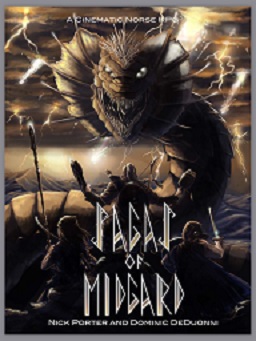 It’s been awhile, and not because there’s been any shortage of Norse-themed role playing games! In this time, we’ve had the 5e derivative Dragon Heresy, a d6 system called Vikingr, older campaign settings such as Hellfrost and systems such as Trudvang Chronicles, and many others. Our topic on this Odin’s Day, however, is the latest of these: Sagas of Midgard.
It’s been awhile, and not because there’s been any shortage of Norse-themed role playing games! In this time, we’ve had the 5e derivative Dragon Heresy, a d6 system called Vikingr, older campaign settings such as Hellfrost and systems such as Trudvang Chronicles, and many others. Our topic on this Odin’s Day, however, is the latest of these: Sagas of Midgard.
Honestly, I had kind of retired from investment in Viking-age rpgs. My home game hasn’t involved the Norse-specific setting for more than a year, my pocketbook doesn’t drip nine golden rings as Odin’s Draupnir does, and there isn’t much utility in owning much more, since I doubt I’d be able to wrest my gamers from my tabletop version of Fourth Age Middle-earth anytime soon. But the Sagas of Midgard Kickstarter advertised savage, fast-paced gameplay and rules for Raiding—an essential component of the northern milieu and one that I had not ever seen treated to my satisfaction. So I backed a PDF copy, mostly out of curiosity.
When I received it, I realized I was encountering something much more than a few interesting mechanics. This looks like a really good game! You’ll notice that I don’t precisely say that it is simply because I haven’t had a chance to run it yet. Character abilities originate from five separate Domains, and each Domain is governed by a Norse deity. At character creation (and during advancement) players spend points within these domains for specific powers and abilities. These are fueled by a currency called Favor, which characters can obtain through a variety of methods, many of them mechanical. The core mechanic is what the designers call the “Rollover System.” Every task and adversary has a “Rollover Score,” usually between 1 and 100, that a PC has to beat (with a roll of d100) to obtain the effect she wants. There are modifiers, of course, resulting from other game mechanics, and a core feature is that the GM never rolls the dice, something shared by a few other systems and (though denying the GM the pleasure of rolling dice) allows her to focus on storytelling and character interaction.
My main criticism, though, is that the rules explanations can be hard to follow (while recognizing reasons for the authors’ organizational choices). I contacted the authors about this, and they told me that they already had been drafting a “cheat sheet” that should be helpful even to new gamers. And, in the midst of my enthusiasm for their game, I succeeded in getting the creators, Nick Porter and Dominic De Duonni, to agree to an interview.
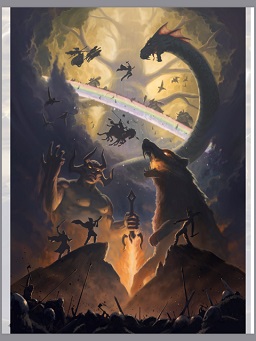 Please describe the “genesis” of what made you decide to design a game such as the Sagas of Midgard?
Please describe the “genesis” of what made you decide to design a game such as the Sagas of Midgard?
Nick: I wish I could say there was some grand plan or that we had always known we’d get into game design, but honestly Sagas of Midgard started almost as a dare sitting at a nearby pizza joint. We had been experimenting with some new systems after finishing a DnD 5E game, but none of them were exactly what we wanted. A few beers in, we said something that I think most TTRPG [table-top roleplaying game] players say at some point in their gaming career: “Let’s just make our own system! That way we’ll have everything we want out of it!” After nursing hangovers the next morning, we settled on a theme (Vikings narrowly beat out magic-infused-Wild West, for the record) and I started reading the source material (Eddas, Sagas) the next week.
Dom: Nick pretty much covered it. This whole endeavor spawned from a drunken suggestion over dinner….we knew we were players that enjoyed the story experience more than the number crunching, but we just hadn’t found the system that let us tell our story. So we decided to come up with our own.
If you haven’t already answered it, what are your early experiences with “that northern thing”? What are some of your main influences, be they literary or game-related, and how specifically have they contributed to the formation of the Sagas of Midgard?
Nick: Once we settled on Vikings as our theme, I realized that while I know the major story beats of Norse mythology (Thor, Odin, Ragnarok, etc) I had never read any of the source material. I had taken a lot of classes on classical mythology in college, but Norse myth was foreign to me. Since I had been watching the show Vikings, the first book Amazon recommended to me was the Sagas of Ragnar Lodbrok, which included the Krakumal, his dying ode. The idea that a Viking Hero’s dying ode is him singing about his victories while dying in a snake pit gave us our first crazy idea: What if players could choose the terms of their character death?
As far as game influences, there’s no one influence, but we’ve “borrowed” good ideas from most of the systems we’ve played. For me, that’s D&D (2e through 5), Shadowrun, Alternity, different iterations of the Cypher System, and Pathfinder. If I’m honest, I think Pathfinder is a very well made system, but it’s the exact opposite of what I was trying to make, so in a weird way when making design choices I’d think about what Pathfinder had done– then try to do the opposite.
Dominic: I’ve always been very into mythology. I’d done a fair amount of exploring the Norse gods and their stories just out of my own curiosity but most of the Sagas were foreign to me. As I got more and more into it I realized that we had reached back to the very source material for just about everything in the Fantasy genre. All the greats pulled from stories of the Norsemen. In creating the game I really wanted to give the players an experience as epic as the sagas I read.
As far as mechanically speaking, I just knew that I wanted the game’s rules to take a back seat to the story. As Nick said, after playing lots of other systems we had a good idea of what worked for us and what did not. Actually, this is how some of the more unique aspects of the game, things like Raiding, “With Joy I Cease” and monster hordes, were developed.
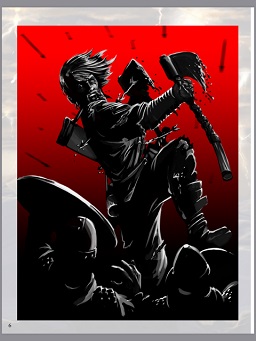 Before constructing your own game, did you explore any of the other northern-themed rpgs out there? Some specifics are Le 7eme Cercle’s Yggdrasill, Andrew Valkauskas’s Fate of the Norns, and of course there are settings for “universal” systems such as GURPS Vikings, Rolemaster’s and the Hero System’s Vikings, and most recently Dragon Heresy for 5e. What are some strengths of these and what pushed you towards your own design?
Before constructing your own game, did you explore any of the other northern-themed rpgs out there? Some specifics are Le 7eme Cercle’s Yggdrasill, Andrew Valkauskas’s Fate of the Norns, and of course there are settings for “universal” systems such as GURPS Vikings, Rolemaster’s and the Hero System’s Vikings, and most recently Dragon Heresy for 5e. What are some strengths of these and what pushed you towards your own design?
Nick: Honestly, we haven’t played any of those, and I blame it on the fact that we didn’t set out to make a system that’d sell on Kickstarter and turn into what it’s become today. We figured we’d make a ruleset, run a few copies off at Kinko’s for our friends, and be done with it. By the time the very first playable (and I use that term loosely) version of our game was finished last September, we were already 62000 words in.
Dominic: We were not aware of those other titles, but honestly I’m glad we didn’t know of them in some way. I think it allowed SoM to be created in an original space….we didnt have any preconceived notion of what a Viking game should look like.
What aspects of northern life, culture or belief were particularly difficult to “gamify” for the Sagas of Midgard?
Nick: Tolkien cribbed a lot from Norse mythology when he made Middle-Earth, so honestly it wasn’t so much how to turn the Norse mythos into a game as how to make it seem like we weren’t ripping off Tolkien and D&D. We changed or removed some of the more historically problematic parts of the old cultures; the idea that magic was “womanly” and thereby wicked. We also included a note about things that were historically common but not necessarily appropriate at a gaming table; e.g., slavery and sexual assault. We can’t tell people how to play the game, but we can ask them to have some sensitivity toward what is still a fraught, emotional subject.
Dominic: Nick said it….the Norsemen were not the nicest folks in antiquity. We wanted to remove some of the more deplorable aspects of their culture without taking away the harsh grittiness of it.
The “rollover” system for Sagas of Midgard strikes me as quite elegant — a simple core mechanic with a variety of player (Hero) resources that diversify character design and make the game tactical. Please describe the formation of this system. Are there other systems that influenced your approach?
Nick: If you look at any TTRPG, no matter how they dress it up they all basically work the same way: “I want to do a thing, am I able to do it?” You see this with Difficulty Classes, Armor Classes, THAC0 (shudder), and any other skill test in any system; the numbers a character has to throw at a task (plus or minus their roll) to be successful. For the Rollover system, we wanted to strip away a lot of the extra veneer and math that came before the roll. I remember in 4E DnD taking 1-2 minutes just to figure out what the DC would be, then the player would roll, and we’d throw situational modifiers until we nearly forgot what we were rolling for in the first place. We decided it’d be more fun to allow one roll (with some easy modifiers) to see if you can “do the thing”, no matter how crazy that thing might be.
Dominic: When developing the roll over system I knew that I wanted it to be simple enough for just about anyone to run or to play. The Skald (game master) sets a Roll Over number for you and if you beat it you succeed. That’s it. Like Nick said, the core of all these game systems is figuring out if you can perform a given action, we feel the Roll Over system does that very well while staying simple and out of the way of the action.
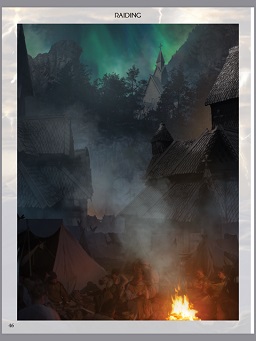 Of what aspect of Sagas of Midgard, be it setting, mechanics or presentation, are you most proud? Please describe how you developed these.
Of what aspect of Sagas of Midgard, be it setting, mechanics or presentation, are you most proud? Please describe how you developed these.
Nick: For me, it’s “With Joy I Cease”. As I said above, it’s one of the first things we figured out, and it really informed the rest of the system. It fits thematically (because Vikings were eager to die in battle and ascend to Valhalla) and it’s created some really interesting, tense moments at the table. We’ve had players at 1 HP who elected not to pull the trigger and survive the fight; we’ve had other players make that same decision, roll a crit fail and die ignominiously, and plenty of players who, in the face of death, ended their character on their terms and felt really, really good about it.
Dom: I’m kind of tied between a couple of different aspects. Raiding and hordes are two of my favorite things in the book but since we’re going to talk about raiding in a moment I will focus on the Horde mechanic. This is something that folks might miss on a first pass through but is something that truly makes fight sequences seem huge and on a very epic level. The Horde is a template that the Skald can lay on top of any of our monsters. Using the Horde template you can make large horde of 50 fire giants to pit against your party of would be heroes. The hordes, based upon their size, get an increased amount of attacks and can occupy multiple range increments. This creates a much more interesting scene for a battle. Instead of whittling away at a solitary monster doing XX damage per hit every round until the monster unceremoniously topples over each, HP of damage inflicted on the horde can be described in a much cooler way. Did you do 15 points of damage to the incoming troll horde? Well, you just swept your axe through their ranks, dropping 5 trolls while sending limbs flying and heads rolling….what a good Viking.
One thing that Sagas of Midgard has that I have not seen in other Vikings rpgs are rules for Raiding. For me, this has been a main challenge in making a Vikings rpg differentiated from traditional rpgs more typically focused on the experiences of the party as a continuum rather than the warband or larger “in-game” community. How did you come upon this, and did you know from the outset that your game would need such a mechanic?
Nick: There are a lot of things about DnD 4E that I didn’t like, but one thing we DID like was how they addressed “skill challenges”: when I ran our 4E game, I modified them to basically act as little non-combat cutscenes with consequences for success or failure. Raiding helped solve a few problems: first, that long travel is often boring in TTRPGs. Second, it fits the theme perfectly. Third, it allows for a “reserve” of faceless would-be Heroes in the event of a likely character death. It’s such a pain to bring in new PCs that have no bond to the party; having them already in the Warband makes it easier for them to integrate into the party so the game can continue without that “uh… who’s the new guy?” vibe.
Dom: I knew that raiding and by extension the Viking Long Boat needed to be featured heavily in the gameplay. After all, the Norsemen were a seafaring culture of pirates. I envisioned the Viking ship to be like your horse in a standard fantasy RPG. As such, we had to develop a way that allowed the raiding mechanic to transport the players around the world and tie them into their next adventure. I think we came up with a very engrossing way to handle travel in the world. It’s no longer a boring slog through the woods to fight a random procession of oddly placed monsters, instead its integral to the story, and even helps your warriors prepare for the difficulties ahead by generating wealth and the favor of the gods.
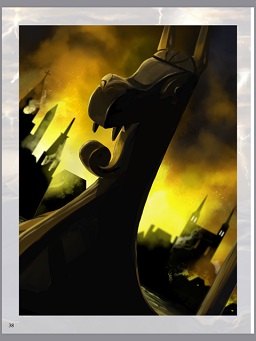 Another aspect that makes your game stand out from others is the “With Joy I Cease” mechanic or, in other words, dying. Do you think that character death is essential to the flavor of a Vikings-inspired game, and how do you think that these boons that Hero death grants to other party members encourage gamers to play more heroically?
Another aspect that makes your game stand out from others is the “With Joy I Cease” mechanic or, in other words, dying. Do you think that character death is essential to the flavor of a Vikings-inspired game, and how do you think that these boons that Hero death grants to other party members encourage gamers to play more heroically?
Nick: As I discussed above, With “Joy I Cease” helps turn character death from something to be dreaded into something to be celebrated. We establish at the outset of the game that this is a system where characters will die often, so if you’re starting Sagas of Midgard you’ve already “bought in” to that idea. Once you’re bought in to the idea that your character may not survive, a character death feels less like you’ve “lost” the battle and more like you’re all trying to overcome challenges and tell a story together. I let my players describe how their character will take out the creature that they’re fighting, and then add on to it to help it feel more heroic. As a result, players often come away feeling good about their character dying, which is something that is, at least for me, novel in a TTRPG setting.
Dom: One thing that Nick and I both disliked about other systems was that once you got past the first few levels this feeling of invulnerability would set in. I personally love the feeling of a low level character that can be killed at any time. That fear drives me to really think about my character’s actions and provides a sense that every decision is vitally important. We wanted that feeling to persist throughout a players Saga. Also, we’re talking about Vikings. The only way for a Viking to feast in the halls of Valhalla was to actually die in battle. Therefore, it’s kind of a big deal. If you want to be a hero….you’ve got to die like one.
Please tell us about the beautiful artwork in the core book.
Nick: Everything art-wise in this book starts with my wife, Leah Porter. She’s a classically trained painter and acted as our Art Director because I have basically no eye for art. She drew her version of Odin in watercolor before we even had the rules finished, and it was really an inspiration to work even faster. She grew up in New Jersey with James Cornell (who did our cover and interior art), who has an art degree from SCAD and currently works on the FXX show Archer as a senior animator. Once we actually got funded, we had money to pay the people we knew (our monster illustrator Jon Stachewicz, James, our graphic designer Cassandra Conklin) and people we found online (Roger Dorico, Robson Michel). Dom and I had final approval, but the art direction in the book is Leah’s contribution, and she did an amazing job.
Dom: All of the contributing artists were amazing and I think the finished products reflect that. They all did a great job capturing the feeling we were going for in our world and were amazing folks to work with.
Where and when might we get our own copies of Sagas of Midgard? What might we expect from Drinking Horn Games in the future?
Nick: Assuming all goes well with the publisher (we’ve hit a few small snags), retail is December 8th on DriveThruRPG and our website (SagasOfMidgard.com), with backer rewards going out before that (the exact date depends on when the publisher gets them to us). Moving forward, we’re going to keep supporting Sagas with Adventures and rules supplements. We also have an idea for another setting using the same basic system but as it’s currently about 3 pages long, that’s all we can really say about it for now.
Dom: We are definitely not stopping here. We’re going to be rolling out additional content for SoM as well as beginning work on a few other ideas that we’ve got kicking around.
A HUGE thank you to our backers, and to everyone who’s shown so much interest in Sagas of Midgard so far. We couldn’t do it without you.
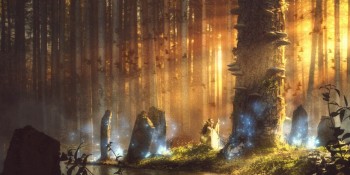
[…] (Black Gate): It’s been awhile, and not because there’s been any shortage of Norse-themed role playing […]